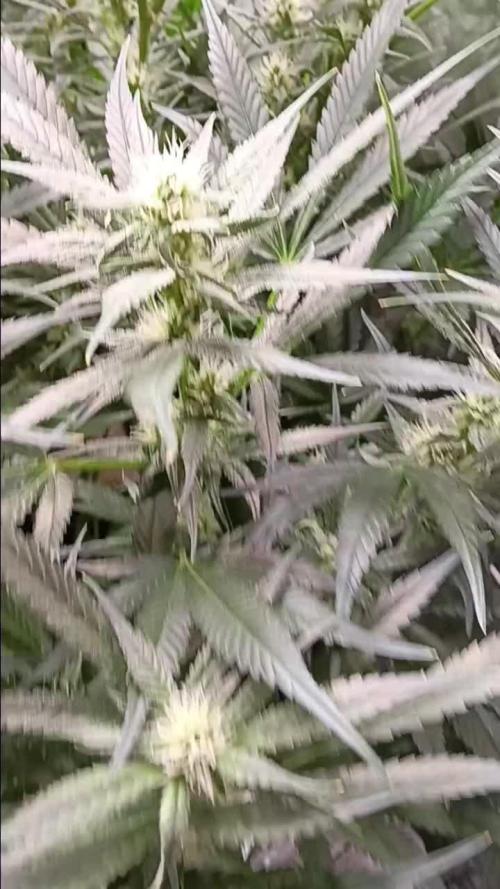By continuing to use the website or clicking Accept you consent to our cookies and personal data policy and confirm that you are at least 18 year old. For details please see Privacy Policy and Terms
Accept
Likes
Comments
Share


@AustinRon
Follow
OG 4Q24 Flower Week 9
Orangegasm (Fem) [ IRIE Genetics ]
12/12 @ Bolt (Day 21)
Germination: 20 November 2024
#3A Earliest Harvest Date: 9 February 2025
#3B Latest Harvest Date: 19 February 2025
_________________________________________
Start of Week: [Wed Feb 5, 2024 CR2 4Q24 57:F:8:1]
End of Week: [Tue Feb 11, 2024 CR2 4Q24 63:F:8:7]
OrangeGasm Fertigation:
- MAX: EC: [ 2.4, mS] #Ramping Down
- LightIntensity MAX: [ 850, µMol/m2/s]
______________________________________
OBJECTIVES
- Ramp EC from 2.4 - 1.0
- Start rolling off Primer A&B/Silica Skin to Resin Bloom . . .
__
Wed Feb 5, 2025
OG 4Q24 57:F:8:1
EC: 2.3
Notes:
#5 looks like a 60 day plant, if so - consider Saturday Harvest …
Runoff
- [x] Amount: [ 0.125 , gal]
- [x] EC: [ 4.4 , mS/cm]
- [x] EC∆: [ 2.5 , mS/cm] # Fried Yet? ;-}
Harvest Dehu
- [x] Amount: [ 1.5 , g]
__
Thu Feb 6, 2025
OG 4Q24 58:F:8:2
EC: 2.3
Refresh Reservoir
- [x] Amount: [ 2 , g]
- [x] EC: [ 2.3, mS/cm]
- [x] Primer A&B: [ 31, ml]
- [x] Silica Skin: [ 15 , ml]
__
Fri Feb 7, 2025
OG 4Q24 59:F:8:3
EC: 2.3
__
Sat Feb 8, 2025
OG 4Q24 60:F:8:4
- [x] Disassemble, Clean Reservoir and Pumps, Reassemble
Refresh Reservoir
- [ ] Silica Skin: [ 15 , ml]
- Dropping Silica Skin due to (sparse to medium) granular precipitate
- [x] Amount: [ 6 , g]
- [x] EC: [ 2.1, mS/cm]
- [x] Primer A&B: [ 100, ml]
EC: 2.1
@1900 - Clear Manifold Filter. (Mainline should be cleared on 1845 feed
__
Sun Feb 9, 2025
OG 4Q24 61:F:8:5
- [x] Dilute to EC 2.0
- Flooded Tent, 2 Gallons PLUS of Runoff. Happy Plants.
- Shout Out Shop-vac. ;-}
EC: 2.0
__
Mon Feb 10, 2025
OG 4Q24 62:F:8:6
EC: 1.8
HAND APPLICATION
Prepped One Gallon of 12-8-7-5 @ 1.8 mS/cm w/ PhotoSynthesis Plus, SLF-100
Reclaimed Dehu Water, ~2 Gallons
Refreshed Reservoir, 2 Gallons Rooted Leaf Hydro no Silica Skin, EC: 1.8 mS/cm
Reduced watering to 5 min, then 1 - 1 -1 -1 -1 -1 -1 -1
(It’s not like they’ve been under-fertigated)
__
Tue Feb 11, 2025
OG 4Q24 63:F:8:7
EC: 1.7
- [x] EC: [ 1.7, mS/cm2]
- [x] Refresh Reservoir
- [x] amount: [ 2.5, gal]
Runoff
- [x] Amount: [ 0.5, gal]
- [x] EC: [ 3.6, mS/cm2]
- [x] EC∆: [ 0.9, mS/cm2] # Better than 2.5!
PLANT POSITIONS
3 5 1 7
4 2 6 8
Likes
5
Share


@TerpTime
Follow
Willkommen zur achten Woche – Blütewoche 4 liegt hinter uns
Wouw – acht Wochen sind schon wieder vorbei! Leider kommt das Update diesmal etwas verspätet, da mich eine Krankheit kurzfristig ausgebremst hat. Die Woche selbst verlief allerdings sehr ruhig. Die tägliche Arbeit ist inzwischen auf ein absolutes Minimum gesunken, da die Ladys ihre Routine gefunden haben und konstant weiterarbeiten. Die Entwicklung bleibt – wie in den Wochen zuvor – durchweg hervorragend. Fast die gesamte Blütezeit liegt bisher im absoluten Sweetspot, was sich nicht nur sehen, sondern trotz Filter und konstantem Unterdruck auch deutlich riechen lässt.
Das Terpenprofil ist bereits jetzt sehr ausgeprägt. Es verteilt einen intensiven, süßen Duft im Raum, der stark an Zitrone, Limone und andere fruchtige Aromen erinnert. Besonders spannend ist dabei, dass sich die Aromen trotz der Geruchsfilterung gut durchsetzen – ein deutlicher Hinweis auf ein kräftiges Terpenprofil und gesunde Pflanzen.
In puncto Wachstum hat vor allem die kleine Nachzüglerin in dieser Woche ordentlich aufgeholt. Mit über 37 cm Zuwachs steht sie nun bei beachtlichen 98 cm. Die Pflanze unten rechts hat sich auf 105 cm gestreckt, oben rechts misst nun 83 cm. Und der dominante Sativa-Phänotyp hat es mittlerweile sogar auf stolze 130 cm geschafft. Da sich das Höhenwachstum bei den meisten weitgehend abgeschlossen hat, geht nun sichtbar mehr Energie in die Ausbildung der Blütenstände – und das merkt man. Die Buds haben in der letzten Woche ordentlich an Volumen und Harz zugelegt und wirken schon jetzt vielversprechend.
Nährstofftechnisch habe ich Green Sensation inzwischen durch Canna PK 13/14 ersetzt. Zusätzlich kam Cannazym zum Einsatz, um die große Wurzelmasse gesund zu halten und den Stoffwechsel zu unterstützen. Leaf-Tucking wird weiterhin regelmäßig angewendet, um den unteren Trieben Licht zu verschaffen, ohne die Pflanzen unnötig zu belasten. Zudem wurden die Ladys in dieser Woche ein letztes Mal entlaubt, um die Luftzirkulation zu verbessern und den Fokus voll auf die Blütenbildung zu lenken.
Besonders zufrieden bin ich aktuell mit der Klimasteuerung – VPD, Luftfeuchtigkeit und Temperatur sind sehr stabil und genau im gewünschten Bereich. Das schafft optimale Bedingungen für die Photosynthese und fördert die Harzbildung in dieser entscheidenden Phase.
Insgesamt bleibt es spannend. Der Platz im Zelt ist inzwischen sichtlich zu knapp, was die Luftzirkulation und Lichtverteilung etwas erschwert. Trotzdem bin ich sehr zufrieden mit dem bisherigen Verlauf und freue mich auf die kommenden Wochen – denn jetzt geht es langsam auf die Zielgerade zu.
Likes
17
Share


@GangbudsGenesgdl
Follow
11/01/21. inicio de semana riego con giga grow y forza cilicia
13/01/21 no se aprecia bien en la foto haha pero ya esta mostrando pequeños pistilos , se rego con
nutrientes rootz.mx gigagrow, forza silicia , y magna flor. 2ml por litro
17/01/21. cierre de semana riegos diario con 0.25lt esta pequeña comenso a mostrar señales de preflor ya con su primer semana 12 x 12
Likes
46
Share


@Miss_Greenthumbs_Garden
Follow
Strain . Blackberry gum 💜
Breeder. Seedstockers 🐿️🧡
Lighting sponsorship . Marshydro Ts1000 & Ts600
Soil & nutrients . Biobizz . ( lightmix) grow and heaven 😍 and biobizz heaven and topmax
Likes
1
Share


@KingPastrulo
Follow
I am giving her an extra week
15 hours total light (decreased by 4h)
Getting longer and bigger the new stems from node. If keep growing I will give them another extra week of Veg.
Weather changing and now sunlight is less intense.
Likes
25
Share


@Ganjeiro420
Follow
Eai família um ótimo final de semana a todos!
Estou muito feliz com o resultado que estou tendo neste início de floração, a planta duplicou de tamanho dês de o último vídeo.
Estou dando 19 horas de luz e 5 horas de escuridão total e acredito que estou tendo um ótimo início, as folhas estão bem verdes com o aspecto bem saudável.
Essa semana diminui a quantidade do fertilizante Grow, mas vou manter a mesma dosagem dos outros.
Saíram vários galhos laterais que estão crescendo a cada dia e enchendo de pestilos, os Buds estão começando a se formar em toda planta o cheiro já está maravilhoso, estou super ansioso pra carburar essa Banana Purple punch, obrigado Fast Buds 🙏
Likes
42
Share


@Ultraviolet
Follow
Thank you. Gave her a cocktail to help with stress. Added 1st net for lateral support, not so much now, but for later. Blue light is absorbed by photoreceptor proteins called phototropins, which trigger a hormonal response that causes cells on the shaded side to elongate, making the plant bend toward the light. Try and fill this side a little. She is quite big already, just needs to find her stride again after the undue torture.
5 apex stems with 20-30 mini cola, let them develop a little, with the apical dominance shattered, all those 20-30 will all compete with each other as soon as that stretch is initiated. Key to a good stretch is making sure the plant is cycling efficiently, with large ATP conversions occurring lights out.
For now, I'm keeping light intensity high. A plant will slow its vertical growth in very high light intensities, leading to a more compact form with thicker stems and leaves. This response is a protective mechanism against light stress, which can damage the photosynthetic apparatus and lead to symptoms like leaf scorching, yellowing, and brittleness. Instead of growing taller, the plant invests its energy into creating a more robust, stress-tolerant structure.
Providing plants with necessary antioxidants helps protect the photosynthetic apparatus by scavenging reactive oxygen species (ROS) that cause damage from excess light.
UV light exposure can impact the xanthophyll cycle by either enhancing its photoprotective role or causing damage, depending on the intensity and type of UV radiation. UV exposure can trigger the synthesis of more xanthophyll cycle pigments to increase the plant's capacity to dissipate excess energy, but it can also cause direct damage, particularly to Photosystem II, and may lead to a decrease in the de-epoxidation state (DEPS ratio) which indicates a reduced capacity to dissipate excess energy.
Plants can respond to UV stress by increasing the synthesis of xanthophyll cycle pigments, such as violaxanthin and zeaxanthin, to improve their photoprotective capacity. UV-induced changes in xanthophyll cycle pigments can be linked to a plant's overall tolerance to high radiation stress. The xanthophyll cycle helps protect against photoinhibition, which is especially important when the plant is exposed to high levels of both UV and visible light. High doses of UV radiation can directly damage photosynthetic components, including the proteins, lipids, and pigments in the thylakoid membranes. Exposure to UV radiation can have a mixed effect on the de-epoxidation state (DEPS ratio) of the xanthophyll cycle pigments. In some cases, UV can inhibit the conversion of violaxanthin to zeaxanthin, resulting in a lower DEPS ratio and a reduced capacity for energy dissipation. However, the total pool of xanthophyll cycle pigments may increase, and this enhanced pool size could provide a greater potential for photoprotection despite a lower DEPS ratio.
The xanthophyll cycle works alongside other mechanisms, such as the accumulation of flavonoids (UV screens), to protect the plant from UV-induced damage.
Blue light repairs 100% UV-induced damage in plants through a process called photoreactivation, which uses a light-dependent enzyme called photolyase. This enzyme uses energy from blue and UV-A light to directly reverse the damaging pyrimidine dimers in the DNA caused by UV-B radiation, a key mechanism for maintaining the plant's genetic integrity.
After carbon, light, water, temperature, and nutrients, the limiting factor of a plant's growth is often its own internal factors or the amount of a key ingredient. Chlorophyll concentration is one such factor, as the amount of this pigment limits how much light can be captured for photosynthesis. Other factors include chloroplast number, respiration rate, and the concentration of carbon dioxide in the atmosphere, as plants are often in a CO2-deficient condition.
60x60x18=64800seconds x 700 = 45,360,000moles. 45DLI
Exposure to 165 µW/cm² of ultraviolet-B (UV-B) light for 3600 seconds = 1 hour, a extremely high, acute dose triggering stress responses and protective mechanisms.
.
The plant's photoreceptor protein, UVR8, senses the UV-B radiation. This triggers a signaling cascade that activates specific genes to protect the plant from damage. In response to the UV-B signal, the plant ramps up the biosynthesis of protective compounds like flavonoids, phenolic acids, and anthocyanins. These compounds absorb UV radiation and accumulate in the epidermal layers of leaves to shield inner photosynthetic tissues. The plant may increase leaf thickness or deposit more cuticular wax, creating a physical barrier to the radiation. The plant will produce more enzymatic and non-enzymatic antioxidants to neutralize the reactive oxygen species (ROS) produced by the UV-B radiation. The plant activates enzymes, including photolyases, to repair DNA damage caused by the UV-B. These repair mechanisms are critical for preventing permanent genetic mutations.
While protective measures are activated, a high dose delivered over a short period can cause stress that overwhelms the plant's defenses.
Photosynthesis is highly sensitive to UV-B. A high dose can inactivate Photosystem II (PSII), damage thylakoid membranes within the chloroplasts, and reduce chlorophyll content, which lowers the plant's overall photosynthetic capacity. Despite repair mechanisms, high UV-B doses can inflict persistent damage on the plant's DNA. One study found that acute, high-dose UV-B had a greater effect on genome stability than chronic, low-dose exposure. The overproduction of reactive oxygen species can cause oxidative stress, leading to the oxidation of lipids and proteins and disrupting cellular function.
Likes
20
Share


@SecretTreasures
Follow
All the plants are healthy and happy. The leaves are now starting to turn deciduous. Miracle Gushers and Banana Creamz are purple, the Hardcore Zoap are yellow to purple. Also, all the flowers are now full of trichomes and the smell when opening the tent is very strong.
Likes
43
Share


@Regenwurm
Follow
Diese erste Woche ist für mich nicht zufrieden stellend. Farbe aller Ladies zu hell, Wachstum in meinen Augen gehemmt da für 7 Tage zu klein. Problem ist noch nicht erkannt, da ich zum ersten mal Advanced Nutrients und das erste mal Autoflowering Seeds nutze. Die Energiesparlampe die ich schon seit Jahren verwende (bei kleinen Töpfen 1 l) war jetzt nicht gut da die Seeds direkt in die großen Töpfe gesetzt wurden und somit der Abstand und Ausleuchtung schlecht waren. Das war bei photoperiodischen Pflanzen kein Problem da immer 2 mal umtopfen. Daher heute der Umstieg auf eine Metal Halogen Lampe 250 Watt. Mal sehen was die nächste Woche bringt. Da ich nur mit Regenwasser gieße habe ich zu dem Advanced Nutrients Sortiment heute noch cal mag gekauft, da auch dies ein Thema sein könnte. Gestartet bin ich mit dem Dünger an Tag 5 mit der hälfte des Düngeplans… ist das so okay?
Temperatur und Luftfeuchtigkeit kann ich als Problem ausschließen da die Werte gut waren
Likes
5
Share


@Eljardindemargarita_grower
Follow
Buenas compis
6 semana ya ...
Esto se va acabando
Afrontamos las ultimas etapas de este seguimiento , en el que comenzaremos a limpiar raíces , en días
Ya parece que van acabando su ciclo , así que irán bien de tiempo ..
Mil gracias
Un saludo
Likes
17
Share


@mcjordan
Follow
Week 11 started, I was hoping for a harvest soon, but looking at buds and comparing to other growers, seems like plants arent quite ready yet. Will harvest at end of week I think.
So week 11 has ended, I got myself a better microscope mid-week, looking through microscope and comparing whats written on the internets it looks like it still isnt quite ready. Perhaps I'll go for an early harvest, what could go wrong?
Will wait few days to decide if want to harvest at next week start or wait much longer. First grow, zero experience. :D
Likes
56
Share


@Aedaone
Follow
The temperatures, humidity, height, and watering volume(if measured) in grow conditions are all averaged for the week. The pH is soil pH. Any watering done by me is well water which is 7.6 pH and 50° F. Coop Poop, Feather Meal, and Soluble Kelp are ml/gallon of soil top dressed. Everything else listed in nutrients is ml/gallon of water fed to plants without checking the solution Ph.
Day 1 we had a high temperature of 88°F with clear sunny skies. I watered about 5 gallons per pot with well water. I added 75 ml Coop Poop, 100 ml feather meal and 50ml soluble kelp top dressed.
Day 2 we had a high temperature of 74°F with sunny skies. I watered about 5 gallons. These girls were still a little hungry
Day 3 we had a high temperature of 79°F with partly cloudy skies. Today I fed 5 gallons liquid feed mixture with 40ml of Agrothrive Fruit and Flower 3-5-5 and 80ml of Biogreaux Molasses 1 - .5 - 5.
Day 4 we had a high temperature of 85°F with sunny skies. I watered about 5 gallons of well water per pot.
Day 5 I didn't get photos but it was a normal day. Lots of sunshine highs about 80°F. I watered about 5 gallons
Day 6 we had a high temperature of 79°F. Skies were sunny and it's really feeling like fall. I watered the #3 about 5 gallons. The number two got 5 gallons of feed. The feed was 100 ml of AgroThrive Fruit and Flower 3-5-5 and 40ml of Biogreaux Black Strap Molasses. I fed the #1 a 5 gallon nutrient solution that contained 120ml of AgroThrive General Purpose 3-3-2.
Day 7 we had a high temperature of 73°. It was sunny, cool, and a dry 35% humidity. The girls are super happy. I watered about 5 gallons today.
This week was a success. The girls have reached their final height. The #3 is at exactly 10'. Thats measured from the top of the pot to the top of the plant. I continue to treat weekly for powdery mildew. Finally the weather is cooperating. I let the canopy get a little out of hand but she's still producing. Only the number 2 smells like white cake. The others have a lemony smell to them.
Likes
25
Share


@Sators
Follow
Hi folks.
Day 29 does again topping for two previous topped branches. Same nutrients.
Day 32 does some bottom leaves trimmed.
Day 35 does set up net and watering with 2L nutrients mix.
Likes
4
Share


@Lazuli
Follow
So this was my third tropicana, so far all different phenos, this was the biggest yielder of them


























